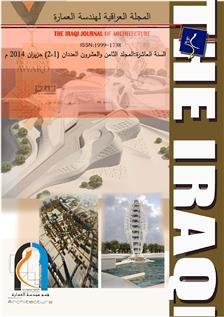The Effect of Religious Monuments in the Plan of the ArabianIslamic city Samarra City – Case Study
Abstract
Religious monument is considered as one of the most distinguished elements which form one of the components of architectural structure, religious monument’s importance stands out from the religious affiliationof the city’s people (Spiritual affiliation). Also considered one of the distinguished architectural elements and recognized architectural identity, which have drawn the mental image for the formation of religious cities in people’s memory. The research depends on studying the plans of the religious cities specifically the Arabian Islamic cities; for its religious importance and the clearness of the religious factor’s impact in its creation and planning, and from reviewing the previous studies those dealt with analyzing the Arabian Islamic city the research problem had been determined in “There is a knowledge gap about the role of religious monuments in planning of the Arabic Islamic citiesâ€,the research hypothesis have been formulated as The religious monument has a regulatory role in planning the Arabian Islamic city, in its impact on axial connection on both local stage and global level.
The research has defined the religious monuments as landmarks or architectural elements of the city’s plan which differentiate in attendant appearance in people’s memory, which is generally showing in worship places, from all that the research’s target has been determined as: Clarifying religious monuments' role in Planning of Arab Islamic cities according to the impact that it have played as a regulatory element for the urban fabric. Samarra have been chosen for the required practical study, considering it’s one of the most important Arab Islamic cities, for what it has of religious monuments, which perform as regulatory power for the local and global connection, research confirms from experience research’s letter using (GIS: ArcView 3.3) computer software for the chosen urban formation that: the impact of the religious factor reflects on the components of the urban fabric of the Arabian Islamic city from both of the form and the space in its planning and regulation, which shows on the group of planning elements for the city, also the religious monuments have an effect on the orientation of spatial connection, and creating public areas in the city, and preparingcomplete spaces which have a high permeability around its locations, As well asits effect on the most complete distribution type in other parts of the system
Downloads
You are free to use the work, but you have to attribute (refer to) the work in the manner specified by the author or licensor (but not in any way that suggests that they endorse you or your use of the work).
IRAQI J. ARCHIT & PLANN grants you the right to publish the metadata of the journal, it's issues and articles under the terms of the Creative Commons Attribution-ShareAlike 4.0 International License.
Author(s) hold the copyright of their aricles without restrictions. However, IRAQI J. ARCHIT & PLANN holds publishing rights for articles and their revisions once the article is published.
Authors can archive pre-prints (ie pre-refereeing) and post-prints (i.e. final draft post-refereeing) versions of the work they submitted to IRAQI J. ARCHIT & PLANN using non-for-profit open-access servers whether on author's personal website and/or institutional repositories including the university or research center where the author work.. For post-prints, only the IRAQI J. ARCHIT & PLANN’s as-published PDF version is permitted and the published source (IRAQI J. ARCHIT & PLANN’s website) must be clearly acknowledged within the archiving webpage.






